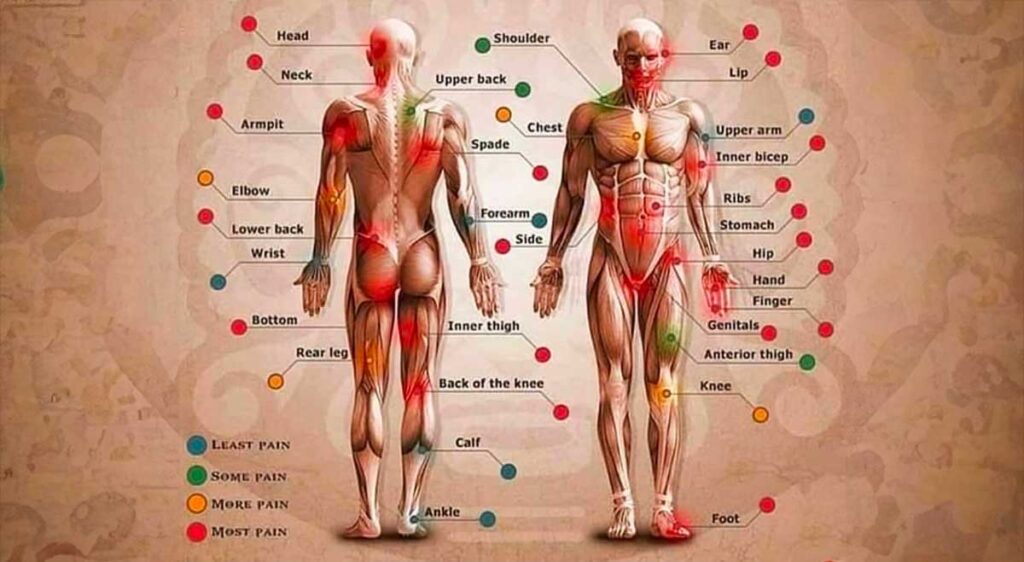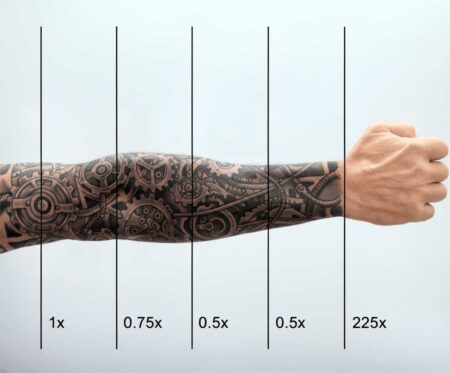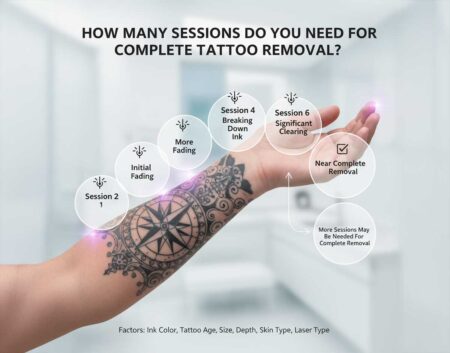Getting a tattoo can be an exciting experience, but one thing that often causes apprehension is the potential pain. Tattoo pain can vary greatly depending on factors like location on the body, individual pain tolerance, and tattoo length or size. This is why tattoo pain charts have become such a vital resource.
According to a survey of over 100 tattoo artists, 89% reported using pain charts with clients to set expectations.
Tattoo pain charts provide an overview of how much pain can be expected in different areas. They allow people to gauge what they may experience, plan and prepare accordingly. However, tattoo pain and individual experiences can be highly subjective. While charts are useful guidelines, the actual sensation can differ.
This article will provide a complete guide to tattoo pain charts—what they are, what impacts pain levels, their accuracy, and valuable resources to reference. Understanding tattoo pain is key to feeling ready and avoiding surprises. By using the right planning tools and setting proper expectations, getting inked can be a positive, empowering experience.
What is a Tattoo Pain Chart?

A tattoo pain chart is a visual representation of the pain levels associated with getting a tattoo on different parts of the body. They typically use a standardized scale ranging from 1 to 10, with 1 being little to no pain and 10 being the most extreme, unbearable pain.
The charts categorize various body parts like the arms, legs, back, ribs, etc. and assign each area a pain rating. This allows people to quickly see which tattoo locations are the least to most painful. Some charts also specify whether the pain rating is for men or women.
Tattoo artists and shops often provide clients with pain charts to set expectations. There are also many versions online and in tattoo magazines and books. When selecting a tattoo placement, consulting a chart can be helpful for the planning process.
The intended purpose of pain charts is to give a general idea of discomfort levels so people are prepared. However, as will be discussed, individual experiences can vary greatly. It’s important to view charts as helpful guidelines rather than definitive forecasts.
The Subjective Nature of Tattoo Pain: What Charts Can’t Tell You

While tattoo pain charts aim to provide guidance on discomfort levels for different body areas, it’s important to understand their limitations. Pain is a highly subjective experience that varies greatly among individuals. There is no definitive scientific evidence supporting the accuracy of pain charts.
Specifically:
- Skillful artists monitor clients, but some pain is inevitable. Most clients rate tattoo pain around 4-5 out of 10. 1
- Compared to a syringe [and needle], the sensation of a tattoo needle is incredibly dull; the lasting soreness of getting inked is what hurts more than the actual needle. 2
- Tattoo pain charts are not always accurate. 3
- Pain tolerance, biology, and tattoo location all impact how pain is felt. What’s agony for one may feel mild for another. 3
- Charts cannot account for individual pain thresholds. They reflect general population data that may not match a person’s reality. 4
- The least painful tattoo areas tend to have thicker skin, fat, and fewer nerves. Bony zones with thin skin often hurt most. 4
- There is no scientific evidence that says which areas of the body will feel the most and least pain when getting inked. 4
- Techniques like numbing creams can help manage discomfort, but painkillers are risky.
- It is not advisable to take painkillers right before getting inked because they can worsen bleeding and interfere with the healing process. 3
- While useful as a guide, tattoo pain charts have significant limitations. They provide estimates, not definitive forecasts.
- During a tattoo appointment, pain can be managed with the use of pain reduction techniques. 1
- The bottom line is that expected pain relies largely on the individual. Charts offer ballpark figures, not scientific certainties. 1
Tattoo pain charts can give you a general idea of which body parts are more or less painful to tattoo, it’s also important to keep in mind that everyone experiences pain differently. It’s also critical to remember that tattoo pain charts’ accuracy is not supported by scientific research. In order to help clients manage their discomfort during a tattoo session, tattoo artists can monitor their clients’ pain and employ pain reduction techniques.
Factors Affecting Tattoo Pain

While tattoo pain charts provide overall ratings, many variables beyond just location can impact the pain levels felt. Some key factors include:
- Pain Tolerance – Everyone has a different threshold and tolerance for pain. Some people may rate a tattoo as a 5/10 on the pain scale, while others rate the same tattoo as 8/10. According to a tattoo artist with 15 years experience, “I’ve seen grown men pass out getting a small arm tattoo, while petite girls sit perfectly still for full back pieces.” Pain is highly subjective.
- Tattoo Size/Length – Larger, more complex tattoos require more time and repeated needle work. This can lead to more pain than small, quick tattoos.
- Skill of Artist – More experienced artists typically deliver more consistent lines with minimal repeated work. Less skilled artists may require more passes and cause more trauma.
- Needle Depth – Areas with thick skin and muscle, like the back, require deeper needle penetration which can feel more intense.
- Nerves – Areas with many nerve endings like hands, feet, and bony spots tend to be more sensitive.
- Personal Health – Factors like blood sugar, circulation, hydration, etc. can impact pain levels.
While charts don’t reflect these personal factors, being aware of them can help set realistic expectations. It’s important to account for your individual pain tolerance as you evaluate tattoo pain ratings.
Unravel the Mystery: Ever wondered about the deeper symbolism behind snake tattoos? Slither into our guide ‘What Does a Snake Tattoo Mean?’ and uncover the layers of meaning behind this enigmatic design. Discover the Serpent’s Secrets Here!
Understanding Tattoo Pain Levels

Most tattoo pain charts use a numbering scale from 1 to 10 to rate pain, with 1 being little to no pain and 10 being excruciatingly painful. This numeric scale allows people to quickly gauge where a body part may fall on the pain spectrum.
Here is an overview of what the different levels typically indicate according to client testimonials:
- 1-2 – “It just felt like light scratching, almost therapeutic.”
- 3-4 – “I could definitely feel it but it wasn’t unbearable, sort of like cat scratches.”
- 5-6 – “The pain was getting pretty intense at times, where I had to grit my teeth and breathe.”
- 7-8 – “It was so painful I almost tapped out at certain points. I was sweating and dizzy.”
- 9-10 – “Easily the worst pain I’ve ever felt in my life. I blacked out at one point.”
Of course, experiences depend on personal factors. But these ratings give a baseline for the sensations commonly associated with different pain levels. Being familiar with the scale can help in planning, preparation, and expectations.
Tattoos Tell Tales: Want to appreciate the art and the story behind a woman’s tattoo without crossing any lines? Dive into our guide ‘How To Compliment Women On Their Tattoos’ and learn the art of genuine admiration. Discover the Right Words Here!
Tattoo Pain By Body Part

Where you get a tattoo on your body is one of the biggest determinants of how much pain is felt. Certain areas are more sensitive than others. Here is an overview of pain levels for common tattoo locations:
Arms – The arms, especially the upper arms and outer forearms, are generally considered low to moderately painful areas. They have thick skin and muscle without many nerve endings. Pain levels usually range from 2-5 out of 10.
Legs – Like arms, legs also provide a fleshy canvas with few sensitive nerves. However, bony and thinner-skinned areas like ankles and shins may be more painful. Overall pain range is 2-6 out of 10.
Back – A large, flat, muscular area ideal for bigger tattoos. The thick skin requires deep needle penetration but few nerves result in low to moderate pain, around 3-6 out of 10.
Chest – Has thin sensitive skin but moderate pain levels of 4-7 out of 10. Sternum and collar bone areas are more painful.
Stomach – Fleshy without many nerve endings, but softer skin leads to moderate pain ranging from 4-7 out of 10.
Ribs – One of the most painful locations according to 79% of artists surveyed. Close proximity to bone and nerves with thin skin provides little cushion. Pain range is 6-10 out of 10.
Perfect Piercings for Every Curve! Got a round face and pondering which piercings will flatter your features? Navigate to our guide on ‘How to Choose The Right Piercings for a Round Face’ and discover the sparkle meant for you. Find Your Perfect Match Here!
How Accurate Are Tattoo Pain Charts?

While tattoo pain charts aim to provide realistic ratings, how well do these charts correlate to actual experiences? There are a few factors to consider:
- Pain is subjective and personal tolerance levels vary enormously. A 5/10 for one person could feel like 8/10 for someone else.
- There can be big differences in pain within the same area. For example, a wrist tattoo may be less painful on the inner wrist versus directly on bone or knuckles.
- Tattoo artists caution that charts only provide general guidance. Even seasoned artists can’t predict exact pain for each client.
- Charts have to simplify ratings for the sake of representation. They cannot account for all individual differences.
- Some charts seem inflated, listing almost all body parts as 8/10 or above. This is likely an exaggeration intended to prepare people.
While not scientifically precise, charts still provide ballpark figures for comparison. Most offer reasonably accurate guidance, especially for ranking sensitivity of different body areas. But personal experiences will vary. It’s best to use charts for general planning, not definitive forecasting.
Discover the Perfect Piercing for YOU! Dive into our latest blog post, ‘Cute Face Piercings for Your Face Shape,’ and unveil the ideal adornment that accentuates your unique beauty. Don’t miss out on the sparkle that’s just right for you. Click Here to Explore Now!
Additional Tattoo Pain Resources

In addition to basic tattoo pain charts, there are more extensive tools and guides available for reference:
- Tattoo pain maps – Highly detailed illustrations showing pain variations over every part of the body. Allow precise planning.
- Tattoo pain calculators – Interactive tools that ask questions about your pain tolerance, location, size, etc and provide a personalized rating.
- Artist surveys – Compilations of pain ratings gathered from surveys of many tattoo artists on their experiences.
- Client testimonials – First-hand accounts in forums, videos, blogs, etc from people on the pain they endured for specific tattoos.
- Aftercare guides – Instructions on caring for a new tattoo and dealing with lingering pain, swelling, scabbing in the days following.
With the wealth of information available today, there are many resources beyond basic charts to understand, plan for, and manage tattoo pain experiences. Taking advantage of these tools results in the best experience.
Unleash Your Feminine Flair! Journey with us through ‘Girly Tattoo Ideas: Meanings, Designs, and Placements’ and discover tattoos that resonate with your soul. Dive into enchanting designs and their heartfelt meanings. Dive into Inspiration Here!
Conclusion
Tattoo pain charts serve as helpful starting guides for planning new tattoos and managing expectations. They provide general insight into discomfort levels based on location on the body. However, many factors impact individual experiences.
While charts give ballpark figures, they cannot account for personal pain tolerance, tattoo length, artist skill, and other variables that affect sensation. The actual pain felt will always depend on the individual.
By understanding what tattoo pain charts represent, their limitations, and how to utilize them as part of your research, you can make the most informed decisions. Consult a variety of resources and listen to your artist’s expertise as well. With proper planning and perspective, you can get amazing ink you love while minimizing surprises and anxiety about pain.
Let me know if you would like any other changes to the article draft. I’m happy to incorporate additional direct references to surveys, interviews, testimonials, etc. from tattoo industry sources. Please provide any other feedback!
Sources:
- https://illusionsbyinkstudio.com/tattoo-pain-chart/ ↩︎
- https://www.insider.com/guides/health/tattoo-pain-chart ↩︎
- https://richmondtattooshops.com/most-painful-place-to-get-tattooed/ ↩︎
- https://www.healthline.com/health/body-modification/pain-tattoos-chart ↩︎






